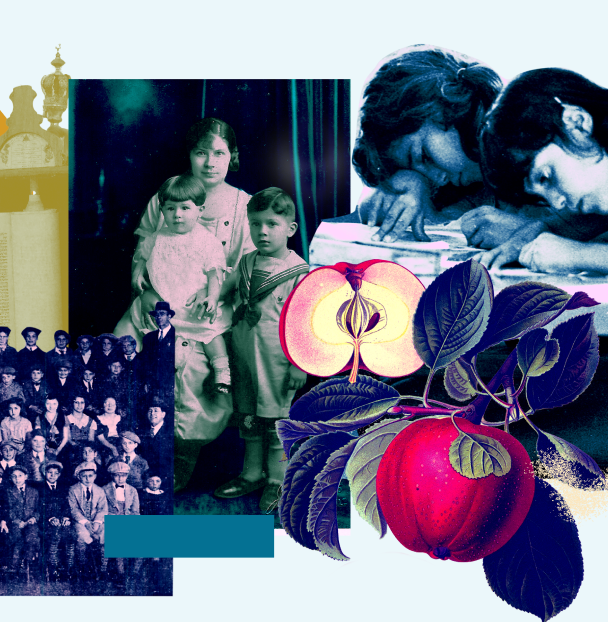Each morning, when I send my kids off to the Seattle Hebrew Academy, I’m entrusting them to a school that, in its own words, “develops students of character and integrity through the pursuit of Torah knowledge and secular studies, connection to the State of Israel, and commitment to our Ashkenazic and Sephardic heritage.”
While this mission statement feels perfectly natural to me, after years of meeting Jewish educators across the United States, I’ve come to realize how unusual this approach is for most American Jewish schools. I suppose Seattle has always been slightly different.
Seattle’s Sephardi community, shaped by leaders whose families came from Ladino-speaking communities in the Ottoman Empire, primarily from Rhodes and Turkey, has always carried a distinct educational ethos. My Papou (grandfather), David Moshe Alhadeff, studied at Seattle’s Sephardic Talmud Torah in 1933, where 120 pupils gathered after public school to learn Tanakh, Hebrew, history, and Sephardic liturgy. Teachers like Haham David J. Behar of Beirut and Albert Levy, a Ladino journalist from Salonica, embodied this synthesis of tradition and modernity. Levy’s Ladino poem captured the vision:
“Levantemos un edifisio a la relejion, fondemos Talmud Torah para los chikos de la nasion, eskolas Djudias, dinyas de mereto, kon un verdadero i Djudaiko esprito.”
(Let us build a structure for our religion, let us establish a Talmud Torah for the children of our nation—Jewish schools, worthy of merit, imbued with a true Judaic spirit.)
In the same neighborhood, another 70 students studied in the home of Reverend Morris Scharhon, who had been educated at both the Alliance Israélite Universelle and an Ottoman Turkish high school. In his private heder (school) — which his young, first-generation American students jokingly called the “hater” — he taught not only traditional texts such as the Torah and the siddur, but also contemporary Ladino and Hebrew works. These schools reflected a balanced path: combining traditional and modern curricula, rooted in Sephardi heritage, and attuned to the current realities.
In the 1940s, Rabbi Solomon Maimon piloted the Talmud Torah to educate local Jewish students who were quickly assimilating into American culture. That afterschool program eventually became the Seattle Hebrew Academy. Sam Israel, a penniless immigrant from Rhodes, amassed a fortune and upon his passing in 1994 bequeathed millions of dollars to Jewish education in Seattle in what became the Samis Foundation. Israel, who never had children, lived an austere life. On his tombstone is written, “I am my brother’s keeper.”
In 1956, Rabbi Maimon also initiated what would become the Sephardic Adventure Camp. Today, at least half of Seattle Hebrew Academy’s students come from Sephardi families — including Rhodesli, Iranian, Bukharian, Yemenite, Turkish, Moroccan, Tunisian, and other backgrounds. Its leadership, educators, board members, and philanthropic supporters (such as Samis) all reflect the enduring strength of the Sephardic community. When my children graduated from kindergarten, it was only natural that they were presented with our community’s Siddur Zehut Yosef, a custom-to-Seattle prayerbook reflecting the liturgy of Turkey and Rhodes.
This is not the case in other places. As Dr. Elana Riback Rand writes, incorporating Sephardi and Mizrahi materials into non-Sephardi schools could be a key component to ensuring a vibrant Modern Orthodox culture in the generations to come. Denise Zami Samstein shares successful tools to do this, and Stephanie Ives reflects on the roles and responsibilities of Mizrahi educators, who may sublimate their own identities in Ashkenazi environments. Many public schools have become hostile to the Jewish experience, to the point of being influenced by global terror networks, as JIMENA director Sarah Levin writes.
Today we must remain committed to the educational mission first entrusted to Abraham:
כִּי יְדַעְתִּיו, לְמַעַן אֲשֶׁר יְצַוֶּה אֶת-בָּנָיו וְאֶת-בֵּיתוֹ אַחֲרָיו, וְשָׁמְרוּ דֶּרֶךְ יְהוָה, לַעֲשׂוֹת צְדָקָה וּמִשְׁפָּט
“For I have known him, that he may command his children and his household after him, to guard the way of God (derekh Hashem), to do righteousness and justice.” (Genesis 18:19)
Jewish survival has always depended on education — regardless of persecution, exile, or expulsion, we have strived and sacrificed to educate the next generation in the ways of our Torah.
But can we do this better? Like some of the students who came away referring to the heder as the “hater,” try as we might to educate our children, we still fail in many ways. By excluding – or completely overlooking – Sephardic contributions to American and global Jewish existence, we are missing an opportunity to instill pride and deeper knowledge of our history.
After all, what is the point of education? When it comes to Jewish education, it’s not just to be smart – though we like that, too. It’s mainly to instill a sense of tradition, peoplehood, and continuity.
This issue of Distinctions highlights the work of educators advancing Sephardi and Mizrahi inclusion by addressing antisemitic bias in curricula, promoting inclusive Middle Eastern perspectives, and emphasizing the importance of Sephardi and Mizrahi education in Jewish schools. It underscores the necessity for all Jews to broaden their knowledge of Sephardic and Mizrahi traditions as essential to understanding Jewish law, culture, and identity, while affirming that these communities are integral to Judaism, not peripheral or exotic. The issue also explores the richness of Jewish life, including the paradoxes and multiple forms of intelligence reflected in its stories, and demonstrates how the teachings of Sephardi hahamim can inform modern Jewish learning.
We can talk all day about the importance of Sephardi and Mizrahi education, but what about the materials that already exist? Are they getting enough attention? At the end of the journal, we are proud to share a curated art exhibit of children’s books that bring to life the experiences of Jews from Turkey, Cuba, Iraq, Iran, Algeria, Morocco, Yemen, Israel, and Seattle, with insights from their authors and illustrators. With these stories and essays, we hope you come away inspired for the future of Jewish education and equipped to bring fresh ideas and resources into your own schools and homes.



